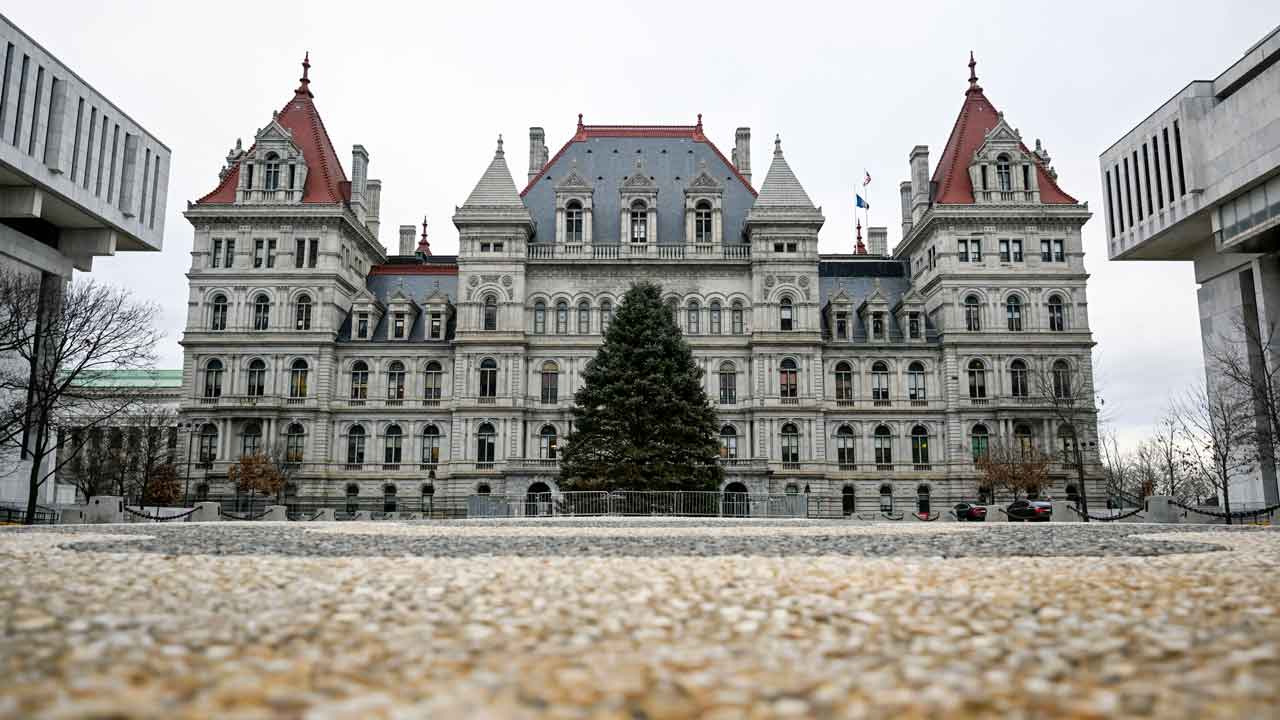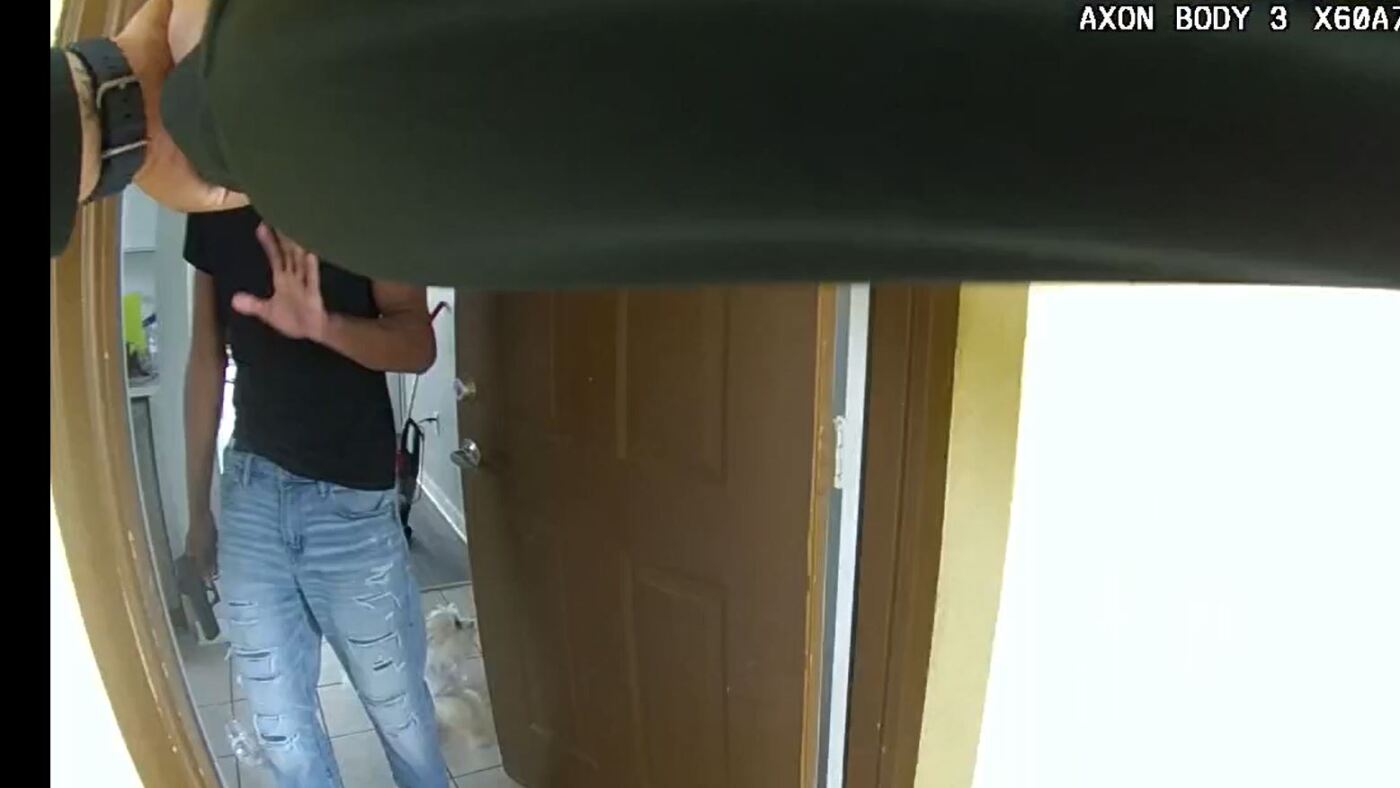Science
Budget deal for NASA offers glimmer of hope for JPL's Mars Sample Return mission

A bipartisan congressional agreement on NASA’s final budget for the current fiscal year offers a glimmer of hope that the space agency’s ambitious but troubled effort to bring pieces of Mars to Earth can recover from devastating cuts that led to hundreds of layoffs at the Jet Propulsion Laboratory in La Cañada Flintridge.
This week, the House and Senate appropriations committees finalized a deal that would grant a minimum of $300 million for the Mars Sample Return mission, which is managed by JPL. That’s a steep drop from the $822.3 million NASA spent on the program last year, and less than one-third of what the Biden administration requested.
Mars Sample Return would deliver rocks, rubble and dust from the Red Planet’s Jezero Crater that has already been gathered and sealed into tubes by the Perseverance rover. The MSR mission envisions a lander that would retrieve those tubes and use a small rocket to ferry them into Martian orbit, where they would rendezvous with a spacecraft that would make the journey back to Earth, arriving roughly five years after the orbiter’s launch.
The ultimate goal is to comb the samples for evidence that life has ever existed on Mars. That job may be left for future generations of scientists who will have access to technologies that don’t yet exist, NASA says.
A joint project with the European Space Agency, Mars Sample Return is an extraordinarily complex technical effort that scientists say would be a crucial step toward future human missions to Mars. Yet the project has been beset with delays and mounting costs.
NASA Administrator Bill Nelson directed the agency to brace itself for that $300-million figure earlier this year. That order has resulted in the loss of nearly 700 staff and contract jobs at JPL since January.
The Senate appeared ready to condemn the mission altogether when it released its draft budget in July, writing that the appropriations committee was “alarmed” by the mission’s slow progress despite steady funding.
As a result, the Senate demanded a year-by-year breakdown of how NASA planned to fulfill the mission within the $5.3-billion then estimated as MSR’s total lifetime cost. Without that, the committee warned, “NASA is directed to either provide options to de-scope or rework MSR or face mission cancellation.”
In the budget agreement released Sunday, lawmakers clarified that the ultimatum in the Senate’s proposal was no longer on the table.
“MSR is the highest priority of the 2022 Planetary Science Decadal Survey but there is concern that the expected launch schedule continues to slip,” lawmakers said in a bipartisan statement from members of both the House and Senate.
Last year, NASA commissioned an independent review of the mission, which deemed MSR “not arranged to be led effectively” and hobbled by “unrealistic budget and schedule expectations from the beginning.” Making its planned 2027 and 2028 launch dates for the lander and orbiter is likely impossible, the review noted, and even a 2030 launch looks dubious without a massive injection of cash far greater than what Congress has budgeted.
NASA’s response to the review is expected this spring. Once that’s in, the current budget allows NASA 60 days to present Congress a plan for the mission’s future. This can include requests to redirect as much as $649 million in its budget to Mars Sample Return, which would raise program spending to the level Biden initially requested.
“The agreement further directs NASA to not engage in further workforce reductions of the MSR program until such report is provided,” the statement said.
In January, 100 on-site contractors at JPL were laid off after NASA told the lab to reduce spending, despite the strenuous objections of California lawmakers. Last month, the lab let go of 530 employees — approximately 8% of its workforce — and 40 additional contractors.
Many of those who lost their jobs were seasoned veterans whose departures shocked co-workers, JPL employees said.
Some of the state’s representatives in Washington expressed optimism that the mission could get back on track.
“This funding agreement is a step in the right direction to ensure that California continues to lead our nation’s space program,” Sen. Alex Padilla, a Democrat, said in a statement.
“The fight isn’t over,” Rep. Judy Chu (D-Monterey Park) said in a statement. “I urge NASA to swiftly apply the new appropriations guidelines so that officials can consider rehiring JPL employees and contractors who were laid off based on an outdated Senate appropriations bill that no longer is being considered by Congress.”
A JPL spokesperson said this week that no staffing changes were expected at the lab before NASA’s response to the review is published. Late last month, NASA’s Office of Inspector General published its own audit of the Mars Sample Return mission, whose projected cost has nearly doubled to more than $10 billion since the program’s inception.
The audit determined that the difficulty of deciding upon a design for the mission’s Capture, Containment and Return System significantly threw off budget and timeline estimates. It also attributed some of the mission’s problems to a mismatch in management and communication styles between NASA and the ESA.
But in reckoning with past mistakes and planning a way forward, management must confront “characteristics intrinsic to big and complex missions like MSR … for example, a full understanding of the mission’s complexity, initial over-optimism, a less than optimal design/architecture, and the team’s ability to perform to expectations,” the audit said. It warned project managers to “not simply attribute past cost growth to the COVID-19 pandemic, inflation, or supply chain issues.”
The budget deal between the House and Senate appropriations committees allocates a total of $24.875 billion for all NASA operations this fiscal year, a $500,000 decrease from last year’s budget. The difference is entirely due to the half-million-dollar cut Congress demanded for the Mars Sample Return mission.
The numbers are not technically final until the budget passes, something that is expected to happen this week without further changes.

Science
Opinion: Most older Americans who need hearing aids don't use them. Here's how to change that

Having depended on hearing aids for nearly three decades, I’m astounded by the lack of Medicare coverage for devices that can solve a problem afflicting tens of millions of older Americans.
Nearly two-thirds of Americans over age 70 have some degree of hearing loss, and over half of those 75 and older experience impairment serious enough to be considered disabling. But most don’t wear hearing aids.
Because the legislation that created Medicare nearly 60 years ago specifically excluded hearing aids, those who rely on the program’s traditional coverage must pay for them out of pocket. That expense is among the chief barriers to wider use of the devices.
Age-related hearing loss impedes basic communication and the relationships that depend on it. Expanded access to hearing aids could therefore do no less than enable more older Americans to establish and maintain the social connections that are essential to a meaningful life.
Hearing loss is like an invisible, muffling curtain that falls in front of anyone speaking. Asking people to repeat themselves can yield irritated and hurtful responses. And it’s hopeless to ask a soft-spoken person to speak up. Sometimes it’s easier just to nod and smile.
Many older people I know choose to avoid social gatherings altogether because they can’t hear well. Without hearing aids, I’d stay home too.
Hearing loss can harm one’s health in other ways. For example, I’ve written about the need for a comprehensive approach to reducing cancer risk at older ages, including preventive services such as colorectal cancer screening. But these services rely on conversations between patients and their healthcare providers. An older patient’s ability to hear and understand such conversations shouldn’t be taken for granted or ignored.
The Food and Drug Administration did improve access to hearing aids by making some of them available without a prescription in 2022, but the over-the-counter devices are inadequate for serious hearing loss like mine. My private health insurance, meanwhile, started covering hearing aids a few years ago, providing up to $2,500 for them every five years. One hearing aid alone can cost that much or more, however.
Despite its limitations, my private coverage for hearing aids is better than nothing, which is what traditional Medicare provides.
Hearing loss is more common among lower-income people and those without advanced education. The toll from noisy workplaces compounds age-related hearing loss for some. One analysis found that most Americans with a serious hearing disability can’t afford the typical price of hearing aids.
Many of the older adults who can’t come up with these significant out-of-pocket expenses spent their working years in low-wage jobs that our country depends on. Denying them treatment for their hearing loss is a lousy way to treat people who gave years of service to our society.
Although some older adults with hearing loss won’t benefit from hearing aids, Medicare coverage for the devices might encourage more beneficiaries to get their hearing tested so they can get the treatment that’s right for them. And while Medicare coverage alone won’t address the stigma some people associate with hearing aids, the availability of newer, more comfortable and less obvious technology might win over some refuseniks.
Legislation reintroduced with bipartisan support last year would finally correct this glaring gap in Medicare coverage by removing the hearing aid exclusion from the law. There’s no reason to delay action on this any longer. Are our representatives listening?
Mary C. White is an adjunct professor of environmental health at Emory University’s Rollins School of Public Health, a Public Voices fellow at AcademyHealth in partnership with the OpEd Project and a former federal epidemiologist.
Science
Second human case of bird flu detected in Michigan dairy worker

A second human case of bird flu in a diary worker has been confirmed in Michigan, state and federal health officials announced Wednesday.
The symptoms were mild, consisting of conjunctivitis. The Texas dairy worker who contracted the virus in March also came down with pink eye.
At a press call on Wednesday, Nirav Shah, principal deputy director of the U.S. Centers for Disease Control and Prevention, said the finding was “not unexpected” and that it was a scenario “that we had been preparing for.”
He said that since the discovery of H5N1 in dairy cattle, state and federal health officials have been closely monitoring farmworkers and slaughterhouse workers and urging farmers and farmworker organizations to “be alert, not alarmed.”
Federal officials say they still believe the human health risk of bird flu is low; however, it underscores the need for people who are interacting with infected or potentially infected farm animals or birds to take precautions, including avoiding dead animals and wearing personal protective equipment (PPE) if there’s a need to be in close contact.
Though a nasal swab from the person in Michigan tested negative for influenza, an eye swab from the patient was shipped to the CDC and tested positive for influenza A(H5N1) virus.
This is the third case of H5N1 reported in the United States. A poultry worker in Colorado was identified in 2022.
Although the symptoms in the three farmworkers in the U.S. have been mild, people elsewhere in the world have suffered more severe illness, including death. According to the World Health Organization, between Jan. 1, 2003, and March 28, 2024, there have been 888 cases of human infection from 23 countries; 463 were fatal.
In preparation for a more widespread outbreak, the CDC updated its guidance for PPE in dairies and issued a nationwide order for healthcare providers to be on the lookout for novel influenza.
On Tuesday, the CDC asked clinical laboratories and health departments to increase the number of influenza samples being analyzed “to maximize the likelihood of catching a case of H5N1 in the community,” Shah said.
The US Department of Agriculture is also expanding its surveillance and support by providing $1500 to non-infected farms to beef up biosecurity, and $100 to producers who want to buy inline samplers to test their milk. The agency will also provide $2000 per farm to cover veterinary fees for testing, as well as shipping costs to send those tests to laboratories for analysis.
There have been no cases of H5N1 detected in California’s dairy herds.
Officials said ongoing analysis of the nation’s dairy supply suggests it is safe to consume, Despite the risk to human health being low, an official with the Administration for Strategic Preparedness and Response said it will make Tamiflu available upon request “to jurisdictions that do not have their own stockpile and are responding to pre-symptomatic persons with exposure to confirmed or suspected infected birds, cattle or other animal exposures.”
Dawn O’Connell, assistant secretary of the preparedness agency, said it started the “fill and finish” process for approximately 4.8 million doses of vaccine “that is well matched to the currently circulating strain of H5N1 through the national pre-pandemic influenza vaccine stockpile program.”
She said the decision to get started on H5N1 vaccines was not a response to any heightened concern, but since it takes several months to fill and finish vaccine doses, the agency “thought it made sense given what we were seeing.”
Science
Gas stoves may contribute to early deaths and childhood asthma, new Stanford study finds

Lung-irritating pollution created by cooking with gas stoves may be contributing to tens of thousands of premature deaths and cases of childhood asthma in the United States, according to a new study published in the journal Science Advances.
For decades, scientists have known the flames from a gas stovetop produce nitrogen dioxide, a pungent gas that can inflame a person’s lungs when inhaled. But for the first time, a team of researchers from Stanford University and Oakland-based research institute PSE Healthy Energy published a nationwide estimate of the long-term health consequences associated with cooking with natural gas and propane stoves.
Researchers concluded that exposure to nitrogen dioxide emissions alone may contribute to nearly 19,000 premature deaths in the United States each year. It has also resulted in as many as 200,000 current cases of pediatric asthma compared with cooking with electric stoves, which do not produce nitrogen dioxide.
Aggressive and impactful reporting on climate change, the environment, health and science.
Stanford researcher Yannai Kashtan noted higher levels of pollution were correlated with the amount of gas that was burned. But pollution also accumulated at higher levels inside smaller homes.
“If you live in a smaller house, you’re exposed to more pollution, and that can lead to income and racial disparities in exposure,” Kashtan said. “In general, folks living in neighborhoods with higher levels of outdoor pollution also tend to have higher indoor pollution. So this environmental injustice extends indoors as well.”
The American Gas Assn., a trade organization representing more than 200 local energy companies nationwide, dismissed the findings as “misleading and unsupported.”
“Despite the impressive names on this study, the data presented here clearly does not support any linkages between gas stoves and childhood asthma or adult mortality,” the association’s president and CEO, Karen Harbert said in a statement earlier this month.
The study is the latest examining the serious health effects associated with breathing fumes from gas stoves, which release planet-warming carbon emissions and a variety of air pollutants. In recent years, the popular household appliance has become a political hot-button issue as policymakers and regulators have weighed environmental impacts against consumer choice.
Many large cities in California, including Los Angeles, have moved toward phasing out gas stoves in newly constructed residences. Earlier this month, the California Assembly advanced a bill to the Senate that would require gas stoves to come with warning labels detailing the pollution and health effects that can arise from cooking with gas.
Gas stoves emit a variety of pollutants, including asphyxiating carbon monoxide, cancer-causing formaldehyde and benzene. The flame also creates nitrogen dioxide, a precursor to smog and a pollutant that can cause difficulty breathing.
Environmental groups say consumers should be notified about these pollutants and the potential harm they can cause.
“Gas stoves create pollution in our homes, increasing the risk of childhood asthma and other respiratory problems for our families,” said Jenn Engstrom, state director for California Public Interest Research Group. “However, this risk has largely been hidden from the public. Consumers deserve the truth when it comes to the danger of cooking with gas. Warning labels will give consumers what they need to make informed decisions when they purchase appliances for their homes.”
Kashtan and other researchers had previously discovered cooking with gas stoves presented a similar cancer risk as inhaling second-hand cigarette smoke. They also found some gas stoves leaked contaminants even when the burners were off.
The effects are especially devastating to children, whose smaller and still-developing lungs need to take more breaths than adults, Kashtan said. Older adults, especially those with cardiovascular or respiratory illness, are also more vulnerable to pollution from gas stoves.
To alleviate indoor air pollution, experts recommend using ventilation hoods and opening windows while cooking,
Starting in 2008, California required new and redeveloped homes to have ventilation that could prevent pollution from building up indoors. But during their research, measuring emissions in more than 100 households across the country, Yannai said they found many kitchens didn’t have ventilation hoods at all.
Although the health effects of breathing these pollutants are clear, researchers still wonder to what degree these conditions could be reversible. As communities take steps to mitigate their exposure or transition away, he said we could soon see the results.
“It’s never too late to stop breathing in pollution,” he said.
-

 Politics1 week ago
Politics1 week agoDem newcomer aims for history with primary win over wealthy controversial congressman
-

 Politics1 week ago
Politics1 week agoSouthern border migrant encounters decrease slightly but gotaways still surge under Biden
-

 World1 week ago
World1 week agoSlovakia PM Robert Fico in ‘very serious’ condition after being shot
-

 World1 week ago
World1 week agoCanadian Nobel-winning author Alice Munro dies aged 92
-

 Politics1 week ago
Politics1 week agoVulnerable Dem incumbents move to the center in key swing states as Biden panders to far-left base
-

 News1 week ago
News1 week agoDespite state bans, abortions nationwide are up, driven by telehealth
-

 World1 week ago
World1 week ago‘Monstrous crime’: World reacts to attack on Slovakia’s prime minister
-

 News1 week ago
News1 week agoSmall but mighty Nimble becomes first mixed-breed dog to win Westminster agility title















